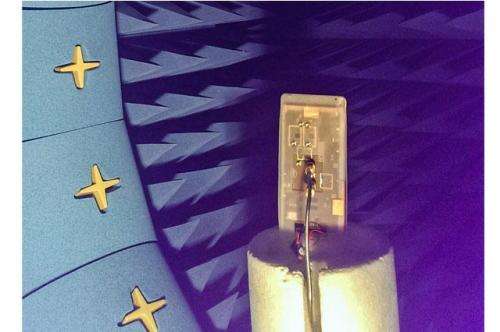New loss mechanism for global 4G roaming

A loss mechanism that has not been an issue in previous mobile handset antennas will become important for global 4G roaming, according to results of experiments carried out in Aalborg, Denmark.
From 4 to 40
The introduction of 4G for higher data rates in mobile communication has created a new need for frequency reconfigurable or tunable antennas. To support 4G, new frequency bands needed to be defined. The bands available varied by region so that in total, 40 different bands have been defined for 4G use across the world.
Globetrotters have come to expect to use their mobile phone wherever they go, but the large number of 4G bands makes it difficult for a single phone to use 4G coverage everywhere. An efficient antenna designed to cover all the 4G bands would be larger than most phones itself, thanks to the fundamental relationships between the volume, bandwidth and efficiency of an antenna.
"To keep the antenna size acceptable for phone manufacturers and maintain good efficiency, we need to reduce the antenna bandwidth. We need to be able to reconfigure the operating bandwidth to different bands," explained Dr Samantha Caporal Del Barrio, from Aalborg University's Antennas, Propagation and Radio Networking (APNet) section. "The number of frequency bands is likely to keep increasing, if so, frequency-reconfigurable antennas will be the only way to address future communication standards."
A rising issue

Unfortunately, tuning an antenna to operate at different frequencies reduces efficiency. Two of the mechanisms involved in this are tuner loss and thermal loss. Tuning involves forcing the antenna to resonate at a frequency other than its natural resonant frequency, this causes high strength fields to concentrate around the antenna structure. The further the frequency is from the natural frequency, the stronger the fields become. Antennas operating in this regime are called high quality factor (Q) antennas. High field strength values translate into large currents on the antenna structure and high voltages between the antenna element and the ground plane.
All tuners have a lossy element, for example, MEMS tunable capacitor-based tuners have an equivalent series resistance that dissipates some of the power received from the antenna. The stronger the fields in the antenna are, the higher the currents passed to the lossy element will be; incurring greater energy loss in the tuner, reducing radiated power. So, antenna efficiency decreases as the antenna is tuned further away from the original resonance frequency. Tuner loss is generally the major loss mechanism.
Thermal loss is incurred because the antenna material, generally copper, is not a perfect conductor. Copper has very good conductivity but very high field concentration over a small area does cause power dissipation as heat. As high field values are needed for this loss to be appreciable, this is only significant in very high Q antennas. Thermal loss has been safe to ignore in mobile antennas because the priority has been wide bandwidth, which means low-Q.
"It is only now, because the bandwidth required for worldwide 4G has become too large for traditional designs, that interest in narrow-band tunable antennas is rising. Therefore the loss mechanism of these antennas hasn't been extensively investigated in the literature," said Caporal Del Barrio
A fundamental afterthought
In their Electronics Letters paper, the team from APNet and Intel Mobile Communication, Denmark, have shown that while thermal loss was negligible for typical low-Q mobile phone antennas, it will become a significant consideration for designers as they move towards tunable, high-Q antennas.
As Caporal Del Barrio explained, "It is essential to know this mechanism because antenna efficiency dictates over-the-air performance, and so, the feasibility of a design. Thermal loss can be a limiting factor to the achievable tuning range. Moreover, while tuner loss can be improved over time and can hopefully become negligible, thermal loss is an intrinsic property of the antenna material."
The effect of thermal loss is normally only discovered late in the design process, when performance measurements are made of a fabricated antenna. This is because, although thermal loss is based on known and fundamental electromagnetic concepts, its previous lack of relevance to mobile antennas has led to it not being well handled in simulation tools; with long calculation times and inaccurate results. However, with the APNet/Intel team finding that in high-Q antennas thermal loss can exceed 1 dB, it becomes an effect that designers will want to account for before committing to fabrication.
More information: "Thermal loss in high-Q antennas" S. Caporal Del Barrio; P. Bahramzy; S. Svendsen; O. Jagielski; G.F. Pedersen Electronics Letters, Volume 50, Issue 13, 19 June 2014, p. 917 – 919. DOI: 10.1049/el.2014.1222 , Print ISSN 0013-5194, Online ISSN 1350-911X
Journal information: Electronics Letters
Provided by Institution of Engineering and Technology


















